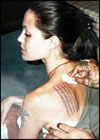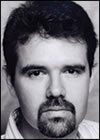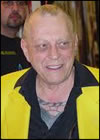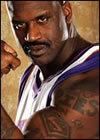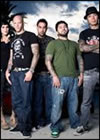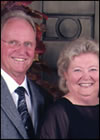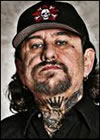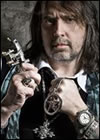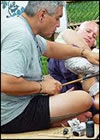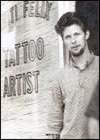|
|
|
|
|
Tattoo Chronicles << 101 Most Influential People in Tattooing << #30-#21 |
Top 101 Most Influential People in Tattooing
So many people, so many stories. The closer we get to the Top 10, the closer we get to the essence of what the tattoo industry is all about. Flamboyant, outspoken, unduplicateable, that’s what the men and women at the top of the list are all about. These are personalities who don’t just participate in the art form, they helped shape it. If the list were a big ol’ jet airliner headed toward immortality, these are the pilots and copilots. For good or bad, these artists and communicators and entertainers and athletes helped point the way, made critical decisions at the crossroads and, seat belts tightened, tray tables up and champagne in hand, put the pedal to the medal and caught the everlasting wind. —Bob Baxter  |
|
30. Angelina Jolie wins a spot on the list for being the show business personality that pretty much gave permission to all the other high-profile cinema celebrities to get inked. The late Rod Steiger was a body art pioneer with his full bodysuit in the movie “The Illustrated Man” (1969), directed by Jack Smite and co-starring Claire Bloom, and Pamela Anderson became famous for her “barbed wire” armband, back in the “Baywatch” days, but Jolie aggressively collected some cool, indigenous, hand-poked tattoos (not to mention her subsequently-erased declaration of love for former husband, Billy Bob Thornton). Hey, getting your ink in Cambodia (a magical Pali incantation), Bangkok (by artist Sompong Kanphai) and Amsterdam (done, she says, under the influence) clearly demonstrates Jolie’s dedication to skin art and may well have set the standard for other young actresses who followed her lead and made tattoo lettering the current bling among the hip, Hollywood in-crowd. |
|
29. Bernard Clark (www.bernardclark.com) has, along with a short list of modern-day lensmasters, such as Bill DeMichele and Justice Howard, taken tattoo photography to a new level. While others have captured images of tattoos and contributed greatly to the ongoing documentation of body art through the ages, Clark’s technical proficiency and artistic inspiration during his thirteen years with Skin&Ink magazine introduced a new, more personal aspect to the art of the tattoo portrait. While Howard relies more on innovative costuming and makeup to enhance visual impact and DeMichele knows just how to add a special sparkle to his photos of tattooed women, Clark captures the subtle relationship of any subject—man, women, biker or prom queen—with their body art. It is said that “a tattoos is a vehicle for showing one’s insides on the outside.” Bernard’s photographs freeze-frame that relationship like no one else on the current scene. DeMichele, Howard and Clark stand out above the rest and set a standard that many aspire to duplicate, but it is Clark and his ingratiating, understated, self-effacing style that stands alone in capturing that elusive moment when a subject and their tattoos are one and inseparable. His work continually inspires others to make similarly intimate and powerful connections with their cameras. |
|
28. Eddie Funk, Crazy Eddie, Philadelphia Eddie: these are all the same guy. Eddie opened the first shop on 4th Street in downtown Philly, which, back in the early 1970s, was one of only a handful of tattoo parlors in the United States. Eddie began tattooing in the early 1950s. He started in Coney Island, New Jersey, next to a freak show. He then moved to Philadelphia in the early ’70s and, ultimately opened four shops. When I first met Eddie he was wearing a canary-yellow sports jacket and powder-blue slacks. His hair was combed up into a unique pompadour that centered catlike, above his forehead, like the hood ornament of a ’50s Pontiac. But jackets and hair product aside, the signature accoutrement was Eddie’s double highball: two hefty glasses filled to the brim with liquid libation from the bar. We’ve all heard the term “two-fisted drinker,” but it was only a phrase until Eddie came along. Eddie, like so many other hard-living icons, suffered a heart attack a few years ago, but he was soon seen at one of his conventions zooming up and down the aisles in a sexy golf cart. We thought he might be headed for his final days, but no. Eddie found a new woman in his life, left the golf cart in the garage and was last seen, full of piss and vinegar, making celebrity guest appearances at various east coast tattoo events. So, because he made such a terrific comeback, because he is one of the top four or five storytellers in the business and because he is such an important survivor of a time when solid-gold characters like him ruled the tattoo world, we welcome him, most enthusiastically, to the list. |
|
27. Shaquille O’Neal is a great basketball player and a big guy. I mean really BIG. I met him at my son Noah’s tattoo studio in the San Fernando Valley (Shaq had brought in his pre-teen son for a pierced earring) and I got a close look at the future Hall of Famer’s Superman bicep tattoo. Although Kobe, Iverson and many of the current crop of all-stars wear lots of ink these days, it was Shaq’s Superman ink that established tattooing as a cool accoutrement to an athlete’s on-court wardrobe. Sure, Dennis Rodman was one of the first to catch our attention, but it was the less frantic, more stable personality of Shaq that legitimized the move. Football players, Olympic swimmers, you name it, whether they hide it under their jerseys, tuck it under their Speedos or let it protrude from their wife beaters, it was the Chairman of the Backboard’s ink that made it kool to decorate one’s skin in the world of sport. |
|
26. Dawn Wilson was the producer (the first fifty episodes) of “Miami Ink,” the TV show that catapulted Kat Von D and the tattoo lifestyle into international prominence. Wilson’s concept of bringing the day-to-day shenanigans of a tattoo shop in Florida into the living rooms of America was not only an eye-opener to the general population but a significant shot in the arm for an industry that was starting to slide into relative obscurity. Maligned by the majority of professionals but adored by the masses, “Miami Ink” enjoyed a significant boost when Von D arrived on the scene. So much so, that, after a tumultuous couple of seasons, plot wise, she was given her own show, “L.A. Ink,” a soap opera packed with trumped-up story lines and manufactured histrionics that one reader described by saying, “If anyone acted in my shop like they do on ‘L.A. Ink,’ I’d fire their asses.” Nevertheless, “Miami Ink” got tattooing over the hump of acceptability and significantly increased traffic into tattoo shops all over the nation. As for Ms. Von D, she continues to attract the crowds wherever she goes, toting with her an increasing amount of bad press, disdain for ethics and a lifestyle that tags tattooing as an industry full of whiners, misfits and publicity hounds. Too bad. It’s a tale often told, but when a 5,000-year-old industry working to elevate itself into the realm of “fine art” is portrayed by a medium (television) whose primary mission is to sell soap, what do you expect? |
|
25. Flo & Don Makofske (www.nationaltattooassociation.com) founded the National Tattoo Association in 1976. Originally named the National Tattoo Club of the World, Flo and Don started this not-for-profit club as an adjunct to their National Tattoo Supply business, with a main focus on a heightened social awareness of tattooing as a contemporary art form. Boasting a membership of some of the world’s most talented artists, the association has become an organization dedicated to the advance in quality, safety standards and professionalism in the tattooing community. Producing a yearly event in a different town each time, the NTA convention is, by definition (it has a limited membership, rules and regs and members-only seminars and meetings), one of the only, perhaps the only, real tattoo “convention” in the industry. How Flo can plan, organize and produce, in far-off towns, full-blown, four-day tattoo events from her phone in Allentown, Pennsylvania, is both a mystery and a tribute to her personal dedication and ingenuity. Tattoo popularity may rise and fall, and new, young artists may replace the fading legends, but one thing is for sure: each year, rain or shine, Flo and Don will be there, with smiles and open arms, putting on their annual gathering with the same enthusiasm they’ve maintained since the first National Convention, in Denver, Colorado, at the Cosmopolitan Hotel, March 23rd—25th, 1979. |
|
24. Gill Montie (www.cd3multimedia.com/GillMontie/) began tattooing via an apprenticeship with Doc Dog, back in 1974. Famous for his ownership one of the West Coast’s most talked about tattoo shop, Tattoo Mania, on Sunset Boulevard in Hollywood, California (and, since 2001, Beaumont, Texas), Montie has also, along with Fred Saunders, produced, for well over a decade, the Inkslingers Ball at the Hollywood Palladium, one of America’s great, rough-edged, old-school tattoo events. One of tattooing’s acknowledged “tough guys,” Montie’s health became an issue a few years back and, while it noticeably softened his demeanor, it has not diminished his affect on the worldwide tattoo scene, especially among those who practice the art in SoCal or Boomtown, Texas. His presence is still felt today, wherever leather jackets, bikers, kick-ass personalities and the private, inner sanctum of daggers-through-the-skull and Harley-emblem tattooing is considered a proper, “not for sissies” lifestyle. |
|
23. Mario Barth (www.mariobarthtattoo.com/) grew up in Austria, where tattooing was not just frowned upon but completely illegal. Mario devoted himself to learning how to tattoo, and, twenty-eight years and over two hundred international awards later, Barth has become the center of his very own international juggernaut. With a celebrity clientele including Lenny Kravitz, Sylvester Stallone, Tommy Lee and Usher, Mario owns five tattoo studios including Starlight Tattoo at the Mandalay Bay Hotel and Casino in Las Vegas and his latest venture, King Ink, at the Mirage. In addition to these monumental tattooing destinations, Mario is the creator and founder of a tattoo pigment company. In 2009, Barth hosted and produced The Biggest Tattoo Show on Earth at the Mandalay Bay Hotel and Casino featuring one thousand artists and attracting over forty-three thousand attendees, which set the Guinness World Record for the largest tattoo convention in history. There’s lots of promoters and hucksters in the tattoo world, but Mario is, without a doubt, one of the most successful. To not only get two Las Vegas resort hotels to house his tattoo shops but to pull off possibly one of the best tattoo events I have ever attended (the numbers and the quality of the artists in attendance were stellar) was mindboggling. I am sure that if a heavily-tattooed man or woman with a full bodysuit ever decides to run for political office or elected Pope, for that matter, Mario Barth will be somewhere in the wings. I think I read Mario saying in an issue of Inc. Magazine (in which he was on the cover) that he wanted to own and operate a tattoo shop in every major city on the planet. None of us will be at all surprised if it happens. |
|
22. Keone Nunes (www.facebook.com/keone.nunes) is one of the world’s leading authorities and practitioners of Polynesian tattoo art. A multilingual graduate of the University of Hawai’i Mānoa in anthropology and Hawaiian language, Nunes was a student of the late Sua Sulu’ape Paulo, who imparted to Nunes a vast technical and spiritual knowledge of hand-tap tattoo techniques indigenous to the ancient Polynesian cultures. An important figure in the renaissance of Hawaiian tattooing, Keone is a sought-after educator, lecturer and authority on the importance of Polynesian history and art. A dear friend and mentor, this wise, self-effacing ambassador makes friends wherever he goes, spreading the gospel of authentic tribal tattooing to the four corners of the earth. Masterful and humorous, Keone is an important link between the art of fast-disappearing cultures and the burgeoning phenomenon of present-day tattoo art. Because of Nunes, primitive tattoo styles and their meanings have garnered a new-found respect and admiration among the true connoisseurs of ethnic and symbolic tattoo art. |
|
21. Zeke Owen (zeke_owen@yahoo.com), or, as he is better known, “Tattoo Zeke,” was the first person to re-open tattooing in Guam, since his uncle, Ernie Sutton, opened his shop there in the 1950s. His first shop was in Rachael and Punchy’s Terminal Café in Agana. Zeke moved to Joe Blas Tavern towards Tamuniing and later back to Hawaii. Zeke started Ed Hardy in the business, in San Diego, many years ago. When he worked at 1033 Hotel St. in Hawaii, on military paydays, Zeke would work nights with Sailor Jerry Collins, around the corner on Smith St., after Jonny Walker left Jerry’s. Mike Malone worked at Zeke’s shop in San Diego, when it was called “The Ace Tattooing Company.” Hardy and Owen had a shop together in San Diego, for a few years. He has worked at many of the older shops in the U.S., with Kazuo Oguri (a.k.a. Hori Hide), in Gifu City, Japan and most everyone in New York City, including Jonathan Shaw. This is just a hint as to the provenance of Zeke Owen, one of the tattoo industry’s bona fide heroes. Owen’s charisma, wit, lifestyle and encyclopedic memory of tattoo legends and lore was captured in his popular “Ask Zeke” columns in Skin&Ink magazine, some of which are reprinted on the www.tattooroadtrip.com blog. His influence on the tattoo community is immeasurable. Others have tried to follow and failed, because, quite simply, when they made Zeke Owen, they broke the mold. 
Tattoo Chronicles << 101 Most Influential People in Tattooing << #30-#21 |
|
|
|

